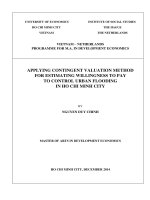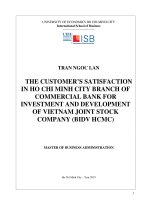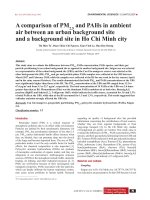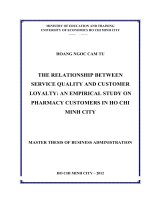- Trang chủ >>
- Mầm non >>
- Mẫu giáo bé
GAME DESIGN FOR PRESCHOOL CHILDREN BETWEEN 5-6 YEARS OLD IN HO CHI MINH CITY BASED ON STEAM APPROACH - Full 10 điểm
Bạn đang xem bản rút gọn của tài liệu. Xem và tải ngay bản đầy đủ của tài liệu tại đây (393 KB, 17 trang )
ISSN: TẠP CHÍ KHOA HỌC HO CHI MINH CITY UNIVERSITY OF EDUCATION
2734-9918 TRƯỜNG ĐẠI HỌC SƯ PHẠM TP HỒ CHÍ MINH JOURNAL OF SCIENCE
Tập 19, Số 6 (2022): 973-989 Vol. 19, No. 6 (2022): 973-989
Website: />
Research Article*
GAME DESIGN FOR PRESCHOOL CHILDREN BETWEEN
5-6 YEARS OLD IN HO CHI MINH CITY BASED ON STEAM APPROACH
Nguyen Thi Kim Anh1*, Nguyen Ngoc Chau1, Nguyen Thi Thanh2
1Institute of Research Education and Economic Development EXIM, Vietnam
2Ninh Thuan Kindergarten, Vietnam
*Corresponding author: Nguyen Thi Kim Anh – Email: anhnguyenire.edu
Received: May 31, 2022; Revised: June 28, 2022; Accepted: June 30, 2022
ABSTRACT
STEAM education for preschool children is considered an educational strategy to help develop
a child’s capability comprehensively according to the motto "playing by learning, learning by
playing". The article investigates the current situation for preschool children between 5 to 6 years
old based on the STEAM approach with 278 managers and preschool teachers in Ho Chi Minh City.
Results of the surveys show that the majority of managers and preschool teachers had correct but
incomplete judgments about games concept, basic characteristics, and structure of games; games
objectives, the importance of games, standards, scientific basis, and game design process for
competence development of preschoolers between 5 to 6 years old. The STEAM based design and
organization of games is relatively new to managers and preschool teachers; therefore, it is only
sometimes held at kindergartens. The difficulties that managers and preschool teachers faced were
the lack of official mechanisms or policies on macro-level regarding STEAM education, and the
application of game methods in teaching preschool children between 5 to 6 years old has not been
exploited or not adequately invested.
Keywords: 5-6 years old preschoolers; games with STEAM approach; game design according
to STEAM approach
1. Introduction
Play is the main activity of preschoolers where they "playing by learning, learning by
playing" (Nguyen, 2000). Being able to approach STEAM education in early childhood
education programs is an approach that brings effectiveness, and practical meaning to the
comprehensive development of capability for preschoolers between 5-6 years old. STEAM
is an integration of STEM (Science, Technology, Engineering, Math) and Art. STEAM
education emphasizes learning based on experiences and practice, thus, creating meaningful
Cite this article as: Nguyen Thi Kim Anh, Nguyen Ngoc Chau, & Nguyen Thi Thanh (2022). Game design for
preschool children between 5-6 years old in Ho Chi Minh City based on STEAM approach. Ho Chi Minh City
University of Education Journal of Science, 19(6), 973-989.
973
HCMUE Journal of Science Nguyen Thi Kim Anh et al.
products for the child in his every day life (Munawar, 2019). The STEAM based game design
for preschoolers between 5-6 years old creates opportunities for children to explore, practice,
and gain experience with science, technology, engineering, art, and math. Thereby,
preschool children between 5-6 years old develop abilities such as cooperation,
communication, problem-solving, and critical thinking, and expand one’s interest, attention,
and concentration. All of these create favorable conditions for the development of science,
technology, engineering, mathematics, and art in a better way (Nguyen, 2019). Therefore,
design and organization of games according to STEAM approach is an important and
essential topic for competence development for preschoolers between 5-6 years old.
However, the reality at kindergartens shows that the application of game methods in
teaching preschool children between 5-6 years old has not been exploited or not
appropriately invested. In addition, at kindergartens, teachers often use the game as a means
of strengthening school hours. Still, they are not fully aware of the importance and
characteristics of the game in the context of comprehensive development of a child's
capabilities and preparing him to enter first grade under the new National Education Program
2018 (Tran, 2021). In this article, the study’s results on the current situation of game design
for preschool children between 5-6 years old in Ho Chi Minh City according to the STEAM
approach are analyzed and served as a practical basis for the research topic.
2. Research contents
Game design for preschoolers between 5-6 years old based on the STEAM approach
Games for preschoolers between 5-6 years old based on the STEAM approach is a type
of game with rules, which is structured as learning games, geared towards awareness to
expand, accurize, and systematize existing symbols to develop intellectual capability and
educate the child's curiosity, in which learning content is integrated into the form of play
(Huynh, 2005). The purpose of developing scientific, technological, engineering, art, and
math competencies and skills such as critical thinking, communication, collaboration, and
creativity is the central purpose of games for preschoolers between 5-6 years old based on
the STEAM approach.
This type of game design is appropriate for the child's psychophysiological
characteristics and the objectives of the Early Childhood Education program. STEAM games
need to be designed according to the child’s interets, understanding, and abilites; it must
always create challenges to stimulate children to think and apply STEAM knowledge to
solve situations in the game. Thereby, it helps children understand the meaning of using
STEAM knowledge to life and promote children to develop creative thinking.
Six principles that should be followed: (1) In line with its purpose; (2) Comprehensive;
(3) Developmental: (4) Appropriate with game structure and characteristics; (5) Diversified; (6)
Ensuring popularity (Pechegova, 2008).
974
HCMUE Journal of Science Vol. 19, No. 6 (2022): 973-989
A variety of steps can be taken to design the game in a STEAM approach for
preschoolers between 5-6 years old. Tran (2011) lists six steps process: (1) Determine the
current cognitive level of preschoolers between 5-6 years old; (2) Identify criteria, and
content; (3) Prepare environment and means of play; (4) Determine the rules of the game;
(5) Determine criteria for game evaluation; (6) Development orientation of the game. The
research team followed Iarezkaia Anna Iurevna's research about the game design process for
preschoolers between 5-6 years old. This process consists of three steps: (1) Preparation,
which includes setting goals for the game, rules of the game, game content, determining
criteria to evaluate the effectiveness of the game, determining limits on time, space, material
selection, toys; (2) Organize the game; (3) Analyze and evaluate the game to adjust the
objectives, content, rules of the game; improve the product through problem-solving
thinking; analyze the achievement of the objectives of the game according to the criteria and
effectiveness of the game (Iarenkaia, 2016; Maria et al., 2020).
The structure of the game consists of three components: cognitive tasks (game
content), game actions (game manipulations), and game rules (rules of the game). All the
games designed based on the STEAM approach always exists a relationship between the
teacher and the child, between the child and their peers, and group work activities, all of
which are the primary activity in the game playing process. This relationship is determined
by the game tasks, actions of the game, or the rules of the game. The difference between
STEAM games and learning games is the child’s independence and initiative, most of which
is shown during the child’s play operations and play actions. Children choose their methods
of action in the flexible, creative application of their insights to solve their playing tasks
effectively (Iarezkaia, 2016; Комаrова, 2012).
For preschoolers between 5-6 years old, through STEAM games, they will have the
opportunity to experience, practice, and explore with available materials and toys. In
addition, intellectual manipulations, intellectual qualities, and intellectual abilities are also
stimulated and developed. Games for preschoolers between 5-6 years old based on the
STEAM approach bring various benefits to the comprehensive development of the child’s
personality, help to form in children the essential qualities and competencies, and create a
solid foundation for children to be ready to enter first grade with the National Education
program 2018.
2.1. Methods and participants
Survey purpose: Assess the awareness level of managers and preschool teachers about
game design for preschool children between 5-6 years old in Ho Chi Minh City according to
the STEAM approach
975
HCMUE Journal of Science Nguyen Thi Kim Anh et al.
Survey content
(1) Awareness of managers and preschool teachers about the concept, basic
characteristics, and structure of STEAM games for preschoolers between 5-6 years old;
Recognize the purpose of organizing the games for preschoolers between 5-6 years old in
Ho Chi Minh City.
(2) STEAM game design for preschoolers between 5-6 years old: Game design based
on the STEAM approach; Scientific basis for STEAM game design for preschoolers between
5-6 years old; STEAM game design process for preschoolers between 5-6 years old according
to the STEAM approach.
Survey area: District 3, 4, 8, 12, Binh Tan, Phu Nhuan, Tan Binh – Ho Chi Minh City.
Participants: 278 managers and preschool teachers.
Table 1. Summary of the level of training, seniority
of management/work of managers and preschool teachers
Managers (N=88) Preschool teachers (N=189)
Criteria Subject of study Public Private Public Private International
Qty % Qty % Qty % Qty % Qty %
2 13.3
Training Intermediate 0 0 0 0 8 5.4 8 32 2 13.3
level College 9 60.1
University 7 10.3 7 35 38 25.5 7 28
55 80.9 12 60 102 68.4 10 40
Post-graduate 6 8.8 1 5 1 0.7 0 0 2 13.3
Total 68 100 20 100 149 100 25 100 15 100
Working Less than five 7 10.3 4 20 16 10.8 6 24 4 26.7
experiences years
5-10 years 11 16.2 8 40 45 30.2 7 28 5 33.3
11-15 years 8 11.7 6 30 30 20.1 7 28 5 33.3
Over 15 years 42 61.8 2 10 58 38.9 5 20 1 6.7
Total 68 100 20 100 149 100 25 100 15 100
Survey period: from January 2021 to March 2021
Survey method:
The research team used quantitative research methods, and selected the target sample
(in the form of a survey) of 278 managers and preschool teachers working in Districts 3, 4,
8, 12, Phu Nhuan, Binh Tan, and Tan Binh in Ho Chi Minh City. Researchers also combined
qualitative research methods, including in-depth interviews with 40 participants,observation
of 10 study activities and play activities, analyses of 10 monthly and weekly plans of the
school; analysis of 10 daily plans of preschool teachers. The survey results collected from
participating managers and preschool teachers at some kindergartens in Ho Chi Minh City,
including STEAM education results, were processed using SPSS software, and in-depth
interviews were transcribed, coded, and grouped into different topics. This helps the research
team prove and clarify the research subjectivity and research contents.
976
HCMUE Journal of Science Vol. 19, No. 6 (2022): 973-989
Data processing tools (see Table 2)
All survey data were processed using SPSS statistical software version 20.0
For quantitative questions that gave the outcome as scores, only the mean value is used
for calculation according to Likert 5 scale.
Range = (Maximum – Minimum)/n = (5-1)/5 = 0.8.
Table 2. Meaning of mean value for the Likert scale
Mean value Meaning
Completely disagree/Completely ineffective/Completely no impact/Completely
1.00 – 1.80 Unfeasible/Never
Disagree/Ineffective/No Impact/Unfeasible/Rarely
1.81 - 2.60 Confused/Somewhat effective/Somewhat an impact/Less feasible/ Occasional
2.61 – 3.40 Agree/Effective/Decent impact/Feasible/Often
3.41 – 4.20 Completely agree/Completely effective/Completely an impact/Entirely
feasible/Always
4.21 -5.00
In addition, the research team evaluated the scale’s reliability using the Cronbach's
Alpha reliability factor, regression analysis, and cognitive level testing of the two groups.
ANOVA was also used to determine differences in awareness levels of managers and
preschool teachers. If the Sig value is less than 0,05, it is statistically sufficient. The
following hypothesis: (1) H0: there is no difference in the level of awareness between the
two groups of managers and preschool teachers; (2) H1: there is a difference in cognitive
level between the two groups. If the Sig value <0.05, H0 is rejected and H1 is accepted;
Conversely, if the Sig value >0.05, H0 is accepted and H1 is rejected. In addition, the topic
uses validation calculations of the correlation between variables (Chi-Square for qualitative
variables and T-Test for quantitative variables).
2.3. Findings
2.3.1. Topic 1. Awareness about the game for preschoolers between 5-6 years old based on
the STEAM approach
a) Awareness of the concept of “STEAM games for preschoolers”
Table 3. Comparison of the awareness level between managers
and preschool teachers about the concept of games according to the STEAM approach
Preschool teachers (N=189) Managers (N=88) Sig
No. Concept of STEAM game Mean Level Ranking Mean Level Ranking
of meaning of meaning
It is the type of action in which the Completely
1 “engine” is not in the performance but 3.89 Agree 7 4.30 agree 3 0.000
in the process of creating the product
It is a game that helps develop a child’s Completely
2 capability of science, technology, 4.17 Agree 5 4.17 agree 6 0.982
engineering, aesthetics/art, mathematics
977
HCMUE Journal of Science Nguyen Thi Kim Anh et al.
It is a game that requires children to
apply much knowledge, skills to solve Completely Completely
3 problems, create products, teamwork, 4.25 agree 2 4.29 agree 4 0.584
socialization. This helps children learn
and develop better
It is a game that requires children to
4 mobilize their own hidden artistic 4.21 Completely 4 4.44 Completely 2 0.003
abilities to solve a problem or create a agree agree
product
It is a game that helps children
5 experience feelings of failure as well as 4.09 Agree 6 4.19 Agree 5 0.243
success in the process of learning and
playing
It is a game to help children and
6 students develop optimally in terms of 4.22 Completely 3 4.19 Completely 5 0.754
aptitude, creativity, active learning agree agree
methods
It is a game that uses science,
technology, engineering, art, and Completely
7 mathematics to guide children to learn, 4.39 agree 1 4.51 Agree 1 0.100
discuss, collaborate and develop critical
and creative thinking
Overall Mean 4.17 4.30
Table 3 shows certain similarities in the level of game concept awareness according to
the STEAM approach for preschoolers of the two groups, mean values range from 4.17 to
4.30, which corresponds to the level of complete agreement. The majority of the
participantsof the two groups completely agreed with the concept of "STEAM game is a
game using Science, Technology, Engineering, Art and Math to guide children to learn,
discuss, collaborate and develop critical thinking, creative," and ranked it 1st in Table 3.
The T- Test results in Table 3 show that the majority of the criteria (5 out of 7) have
Sig>0.05, so H0 hypothesis was accepted, and H1 was rejected. This means there is no
difference in opinion of the concept of the game according to the STEAM approach for
preschoolers of the two groups of preschool teachers and managers.
b) Types of games are usually held for preschoolers between 5-6 years old at
kindergartens
Although 278 preschool teachers and managers have correct awareness of STEAM
game concept, the results shown in Figure 1 below help to assess the difficulties in managing
and organizing STEAM games at kindergartens.
978
HCMUE Journal of Science Vol. 19, No. 6 (2022): 973-989
Figure 1. Types of games organized
for preschoolers between 5-6 years old at kindergartens
Figure 1 shows a noticeable difference in the awareness the participants studying the
organization of STEAM games with the basic types of games at kindergartens. The statistical
significance of the overall mean value of the two groups of subjects was spread along with
the range from 2.79 to 4.11. When the value is arranged based on the frequency level,
different types of games such as learning, construction, physical, and drama games are
ranked as “often” to “always”. It is worth emphasizing that the STEAM game corresponds
to "Occasionally" with Mean = 2,79 in terms of implementation level.
Table 4. Comparison of reality in terms of assigning game organization for preschoolers
between 5-6 years old between managers and preschool teachers at kindergartens
Managers (assignment) Preschool teachers (organization)
(N=88) (N=189)
No Game types Level of Level of
meaning meaning
Mean Ranking Mean Ranking
1 Learning games 4.41 Always 1 4.11 Often 1
2 Contruction games 4.35 Always 2 4.03 Often 2
3 Physical games 4.34 Always 3 3.90 Often 3
4 Drama games 4.16 Often 4 3.59 Often 4
5 Roleplay game 4.07 Often 5 4.01 Often 5
6 STEAM-based games 3.06 Often 6 2.79 Occasionally 6
Table 4 shows the difference between the frequent assignment of managers and the
reality that preschool teachers only sometimes organize for preschoolers between 5-6 years
old to play games according to the STEAM approach. Preschool teacher 1 shared: "STEAM-
based games are a type of game that aims to develop children's abilities, create conditions
for children to practice, experience, create meaningful products but teachers like us have not
been trained in the design and organization of this game, especially our school principal has
979
HCMUE Journal of Science Nguyen Thi Kim Anh et al.
not assigned any STEAM games in the class." Meanwhile, manager 1 said, "We have
encouraged teachers to design and organize a variety of games for children to promote their
positivity, including games according to the STEAM approach." Futhermore, the research
team read ten monthly and weekly plans of kindergartens; and 10 daily plans of preschool
teachers. However, the evidence of frequent assignment and the occasional organization of
the game according to the STEAM approach at kindergartens in the selected survey areas is
quite vague:
c) Awareness about the game structure
Table 5. Comparision of the awareness results in the structure of the game
Structure of Preschool teachers (N=189) Managers (N=88)
No the STEAM Mean Level of Ranking Mean Level of Ranking Sig
game meaning meaning
1 Game name 4.01 Agree 9 4.35 Completely 2 0.000
agree
2 Purpose of the 4.15 Agree 4 4.35 Completely 2 0.001
game agree
3 Toy 4.24 Completely 3 Completely 3 0.600
4.28
agree
agree
4 Play situation 4.04 Agree 8 4.35 Completely 2 0.000
agree
5 Play content 4.27 Completely 2 Completely 2 0.216
4.35
agree
agree
6 Play theme 4.06 Agree 7 4.35 Completely 2 0.000
agree
7 Role play 4.00 Agree 10 4.28 Completely 3 0.003
agree
8 Play action 4.09 Agree 6 4.28 Completely 3 0.023
agree
9 Rules of the 3.99 Agree 11 4.28 Completely 3 0.002
game agree
Children's 4.14 Agree 5 4.20 Agree 4 0.513
10
products
Direction of
11 development, 4.28 Completely 1 Completely 1 0.150
4.38
improving the agree
agree
game
Overall Mean 4.12 4.31
980
HCMUE Journal of Science Vol. 19, No. 6 (2022): 973-989
Table 5 results showed that the awareness level of the game structure had a mean value
ranging from 3.99 (agree) to 4.28 (completely agree). Similarly, the mean value of managers
ranges from 4.20 to 4.38, which is at “completely agree” level. The results of the T-Test in
Table 5 show that the majority of the criteria (7 out of 11) have Sig value <0.05, so H1
hypothesis was accepted and H0 is rejected. In summary, according to STEAM approach,
there is a meaningful difference berween the awreness level of preschool teachers and
managers of the game structure for preschoolers between 5-6 years old.
d) Awareness of basic characteristics of games
Basic characteristics of games for preschool children between 5-6
year olds according to STEAM approach
12345678 Bring happy feelings to the child when using full creativity 4.07 4.51
capability 4.03
4.31
Ensure the innocence, natural development of the child 4.07 4.48
3.96 4.47
Learn based on discovery and experience
Managers 4.29
Children get to actually play - play is the main activity 4.44
Create opportunity for children to experience, trigger their
4.34
development 4.51
Not forcing children to memorize too much knowledge
4.23
STEAM games bring freedom, independence to the child 4.39
4.42
Clear objectives, ensure the game logic 4.47
Preschool teachers
Figure 2. Basic characteristics of games
for preschool children between 5-6 year olds according to the STEAM approach
Figure 2 shows a meaningful difference between the awareness level of preschool
teachers and managers about the characteristics of the games according to STEAM approach.
The results show that managers had a higher level of agreement than preschool teachers. The
overall mean value of awareness level of preschool teachers is 4,17, which is at the “Agree”
level. The overall mean value of managers is 4.30, which reflects the “Completely agree” level.
e) Awareness of the purpose of organizing games
981
HCMUE Journal of Science Nguyen Thi Kim Anh et al.
Table 6. Comparison of the awareness level between preschool teachers and managers
on the purpose of organization games for preschoolers between 5-6 years old
according to STEAM approach
The purpose of Preschool teachers (N=189) Managers (N=88) Sig
organizing games for
No preschoolers between 5-6 Level of Ranking Mean Level of Ranking
years old in the STEAM Mean meaning meaning
approach
1 Help children develop 4.27 Completely 6 4.51 Completely 2 0.002
comprehensively agree agree
Create conditions for Completely Completely
2 children to experience and 4.41 agree 1 4.58 agree 1 0.010
practice
3 Satisfy the child's need of 4.35 Completely 3 4.07 Agree 7 0.015
play agree
4 Meet the needs of parents 3.91 Agree 10 4.04 Agree 8 0.181
5 Develop creative thinking 4.37 Completely 2 4.47 Completely 3 0.192
agree agree
Develop the ability to
6 detect and solve problems 4.30 Completely 4 4.36 Completely 5 0.495
scientifically and logically agree agree
with integrated knowledge
Equip needed skills to
7 become creative and 3.97 Agree 9 4.35 Completely 6 0.000
independent-thinking agree
individuals
Develop integrated
8 learning and experiences 4.08 Agree 8 4.35 Completely 6 0.000
for children to solve agree
practical problems
Develop confidence to
combine knowledge from
9 all different fields in a 4.11 Agree 7 4.35 Completely 6 0.004
creative way to explore to agree
solve useful problems in
practice
Develop creativity, critical
thinking, collaboration,
10 problem -solving, 4.28 Completely 5 4.38 Completely 4 0.258
technological capability, agree agree
science, engineering,
mathematics, and the arts
Overall mean 4.21 4.35
982
HCMUE Journal of Science Vol. 19, No. 6 (2022): 973-989
Table 6 shows that the Overall Mean=4.21 for the awareness level of preschool
teachers and the Overall Mean of managers = 4.35, both of which are at “Agree” level. Both
groups agreed on purposes such as: "Creating conditions for children to experience and
practice,"; "Developing creative thinking", "Developing the ability to detect and solve
problems scientifically and logically with integrated knowledge". However, on the statistical
level of the T-Test, 6 out of 10 criteria are recorded with Sig<0.05, which shows a significant
difference between the awareness level of preschool teachers compared to managers, or in
other words, between the two groups studied were no similarity in purpose 1,2,3,7,8,9 when
organizing games for 5-6 year olds according to STEAM approach.
2.3.2. Topic 2. Game design for preschoolers between 5-6 years old
a) Standards to be ensured when designing games for preschoolers between 5-6 years old
according to STEAM approach
Table 7. Comparison of awareness level between preschool teachers and managers
about game design standards for preschoolers between 5-6 years old
according to STEAM approach
Designing games Preschool teachers (N=189) Managers (N=88) Sig
No standards Mean Level of Ranking Mean Level of Ranking
meaning meaning
Ensure the goal of the game Completely Completely
1 to develop comprehensive 4.16 agree 3 4.44 agree 3 0.000
competencies for children
Play motto (which is an Completely Completely
2 important factor in controlling 4.10 agree 5 4.35 agree 5 0.004
a child's learning activities)
Achieve the goal, prepare
3 preschool children 4.01 Completely 7 4.31 Completely 6 0.000
between5-6 years old to agree agree
enter first grade
4 Bring joy and happiness to 4.16 Completely 3 4.47 Completely 2 0.000
children agree agree
Create curiosity, Completely Completely
5 imagination, challenges, 4.17 agree 2 4.51 agree 1 0.000
control ability of the child
6 Ensure visualization based 4.10 Completely 5 4.47 Completely 2 0.000
on the child's experience agree agree
7 Ensure the child's creativity 4.13 Completely 4 4.39 Completely 4 0.001
in the game agree agree
8 Clearly define the game 4.17 Completely 2 4.39 Completely 4 0.003
mission, rules of the game agree agree
9 Ensuring competition and 3.90 Completely 9 4.25 Completely 8 0.000
cooperation factor agree agree
10 Changes and adjustments 4.02 Completely 6 4.25 Completely 8 0.006
available agree agree
983
HCMUE Journal of Science Nguyen Thi Kim Anh et al.
Designing games Preschool teachers (N=189) Managers (N=88) Sig
No standards Mean Level of Ranking Mean Level of Ranking
meaning meaning
Create conditions for Completely Completely
11 children to roleplay or play 3.96 agree 8 4.25 agree 8 0.004
simulated plays
12 Ensure feedback on the process 4.18 Completely 1 4.28 Completely 7 0.210
of play, the game result agree agree
Overall Mean 4.09 4.36
Table 7 shows that there is a significant difference between the awareness level of
preschool teachers and managers about the standards to be ensured when designing games
for preschoolers between 5-6 years old according to the STEAM approach. Managers have
a higher level of agreement than preschool teachers (Overall Mean = 4,36 vs 4,09). In addition,
T-Test results from Table 7 show a statistically significant difference between the awareness
level of preschool teachers and managers in the context of game design standards for
preschoolers 5-6 years according to the STEAM approach, showing that with 11 out of 12
criteria have Sig value <0.05.
b) Awareness of the scientific basis for game design
Table 8. Comparison of awareness level of preschool teachers and managers
about the scientific basis to design games for preschoolers between 5-6 years old
according to the STEAM approach
Preschool teachers (N=189) Managers (N=88) Sig
Game design’s scientific basis according to
No
the STEAM approach Mean Level Ranking Mean Level Ranking
meaning
meaning
1 Based on the objectives of the Early 4.10 Agree Completely 2
Agree 6 4.48 agree 0.000
Childhood Education Program
Based on time distribution of implementation Completely
2 organization for the Early Childhood 4.11
5 4.47 agree 3 0.000
Education Program
3 Based on caring and education plans 4.15 Agree 3 4.44 Completely 5 0.000
implemented according to daily routine
agree
4 Based on regulations under the Standards of 4.07 Agree 8 4.42 Completely 6 0.000
developmenf for 5-year-old children Agree
Agree agree
Agree
Based on the purpose of promulgating the Completely
5 Standards of developemenf for 5-year-old 4.08 7 4.39 agree 7 0.000
children
Based on the alignment on caring and Completely
6 education of children between school, family 4.05 9 4.27 agree 9 0.005
and society
Based on the purpose of raising awareness of
7 the development of children to have the 4.12 4 4.49 Completely 1 0.000
coordination of capability development agree
education for children between 5-6 years old
984
HCMUE Journal of Science Vol. 19, No. 6 (2022): 973-989
Preschool teachers (N=189) Managers (N=88) Sig
Game design’s scientific basis according to
No
the STEAM approach Mean Level Ranking Mean Level Ranking
meaning
meaning
8 Based on the game characteristics according 4.08 Agree 7 4.45 Completely 4 0.000
to STEAM approach
agree
9 Based on the principle of game design 4.21 Completel 2 4.37 Completely 8 0.040
according to STEAM approach y agree agree
Based on the purpose of the game to Completel Completely
10 developcomprehensive competencies for 4.33 y agree 1 4.45 agree 4 0.140
children
Overall Mean 4.12 4.42
Results in Table 8 show a significant difference in the evaluation level of the scientific
basis for game design, according to which managers have a higher agreement level than
preschool teachers. This is also demonstrated through 9 out of 10 criteria with Sig value
<0,05. This emphasizes that there is a difference between the awareness level of preschool
teachers and managers on the scientific basis in game design according to STEAM approach.
Manager 2 states: "Based on the purpose of raising awareness of children's development to
have the coordination of capability development education for children 5-6 years old is an
important foundation for game design". Preschool teacher 2 shares a similar opinion: "Based
on the purpose of the game to develop comprehensive competencies for children is the basis
of game design according to STEAM approach".
However, preschool teacher 3 shared a difficulty in designing games according to the
STEAM approach, saying that, "Because I were not trained or read any professional
documents on STEAM education, for example characteristics of STEAM games, so I have
not identified the right scientific basis to design the game according to STEAM approach.
Particularly, preschool teachers are not ready to design and organize STEAM games
because they have not been directed by kindergartens’ managers."
c) Game design process for preschool children
Process 3 Another
10% process
2%
Process 2 Process 1
18% 70%
Figure 3. Game design process
for preschoolers between 5-6 years old according to STEAM approach
985
HCMUE Journal of Science Nguyen Thi Kim Anh et al.
Figure 3 results show that 70% of preschool teachers and managers chose to design
games for preschoolers between 5-6 years old according to the STEAM approach, which
includes the following steps: identify goals; name the game; game rules or game contents;
game means and conditions; evaluate games; develop games.
Table 9. Comparison of awareness level between preschool teachers and managers
about game design process for preschoolers between 5-6 years old according to STEAM approach
Preschool teachers (N=189) Managers (N=88)
No Game design process Mean Level Ranking Mean Level Ranking
4.30 meaning 1 4.43 meaning 1
Determine the objectives of the 4.23 Completely 2 4.41 Completely 3
1 4.21 3 4.43 2
4.24 agree 4 4.39 agree 5
game 4.22 Completely 5 4.44 Completely 4
2 Orient game development 4.26 6 4.43 6
3 Define the rules of the game 4.21 agree 7 4.44 agree 7
4 Define play content 4.21 Completely 8 4.39 Completely 8
Prepare game means and agree agree
5 Completely Completely
conditions agree agree
6 Specify a game name Completely Completely
7 Define game review criteria
agree agree
Evaluate the results of play and Completely Completely
8
agree agree
adjust Completely Completely
agree agree
Completely Completely
agree agree
Overall Mean 4.24 4.42
Results in Table 9 show that both teachers and managers have a positive evaluation of
the steps of the STEAM game design process reflected with many answers of "Completely
agree". Most of them think that the first step "Determine the objectives of the game" should
be ranked at the first place. Clear objectives will help identify the content that needs to be
combined and integrated to develop STEAM capability for children. Overall Mean values
are 4.24 and 4.42, both of which correspond to the level of "Completely agree”.
Table 9 shows that preschool teachers and managers have the proper awareness with
high rankings (2nd and 3rd) of “Completely agree” about the step "Define the rules of the
game". However, in fact, many games introduced do not properly express the characteristics
of the game according to the STEAM approach, most of which are too lengthy, not able to
attract the child’s attention from the beginning of the game organization. The game itself
must gain the child’s curiosity and interest, trigger them eager to learn, explore, experience,
and develop their capability for cooperation and creativity.
The research team conducted a direct interview with preschool teachers and managers
in Districts 3, 8, 12, and Phu Nhuan. Preschool teacher 4 stated, "I understand the basics of
986
HCMUE Journal of Science Vol. 19, No. 6 (2022): 973-989
STEAM; organize practical activities, apply to teaching practice according to the motto of
respecting and maximizing the creativity of children. Teacher is just the one who gives the
problem, the direction, and the children will be the ones who solve the problem." Manager
3, who has 11 years of experience in the field, also shared her thought, "STEAM education
program helps children learn not only to learn by heart, but also learn as quickly as possible
when it is applied to their daily lives. Therefore, each knowledge or skill will become
meaningful when it is associated with creating a specific product such as paragliding, pasta
tower, rock shooting, adorable robots, etc. For each scientific principle to be specific and
directly applied by the children, such as to invent their favorite toy. Thereby, this strongly
affects children’s interest and passion."Manager 4 mentioned some difficulties such as "the
lack of official mechanisms or policies on macro-level regarding STEAM education and the
limited capability of teachers in applying game methods to teach preschoolers between 5-6
years old".
3. Conclusion
Survey results can be summarized in the following primary points:
1) STEAM games are only occasionally held at kindergartens despite the high awareness
level of preschool teachers and managers. They understand the importance and the positive
impact of STEAM education and games to the development of comprehensive capability for
preschoolers between 5-6 years old. The analysis mentioned above shows that there should
be a steering mechanism for the organization of STEAM education for preschool level. It is
necessary to organize professional training for teachers on how to design and organize
STEAM games. This will help preschool children develop their capabilities and
qualifications to prepare for first grade under National Education Program 2018.
2) The above figures show a meaningful difference between the level of awareness of
preschool teachers and managers in terms of characteristics, structure, purpose, and
standards to be ensured when designing STEAM games for preschool children between 5-6
years old. Awareness of the scientific basis, game design process according to the STEAM
approach is suitable to the specific position, functions, and responsibilities of preschool
teachers and managers.
3) Game design for preschoolers between 5-6 years old based on the STEAM approach
is to bring Science, Technology, Engineering, Art, and Mathematics to children in a simple,
gentle way, closely related to their daily items, toys or materials, brings joy and exciting
things to children in different activities in their lives. According to preschool teachers and
managers, besides methods and application, STEAM education will help teachers to be more
active, promote creativity, bring various practical effectiveness in building and organizing
the educational environment, and contribute to the implementation process of the current
Early Childhood Education Program and help preschool children between 5-6 years old to
develop their competencies.
987
HCMUE Journal of Science Nguyen Thi Kim Anh et al.
Conflict of Interest: Authors have no conflict of interest to declare.
REFERENCES
Espigares-Gamez, M. J., Fernandez-Oliveras, A., & Oliveras, M. L. (2020). Application of traditional
Jamaican games in Early Childhood and Elementary Intercultural Education. Retrieved from
/>
rs_Application_of_traditional_Jamaican_games_in_Early_Childhood_and_Primary_Intercul
tural_Education
Huynh, V. S. (2005). Thu nghiem he thong tro choi hoc tap nham nang cao hieu qua phat trien tri tue
cue tre mau giao 5-6 tuoi [Experimenting with a learning game system to improve the
efficiency of intellectual development of preschool children between 5-6 years old]. Journal
of Psychology, 10(79).
Iurevna, I. A. (2016). Educational games as a means of intellectual education of older preschoolers.
Thesis for pedagogical science candidate degree. Voronezh State University.
Kannan, Amr. (2012). Learning through games: Essential features of an educational game. Syracuse
University. Retrieved from />
Learning_through_Games_Essential_Features_of_an_Educational_Game
Munawar, D. (2019). Implement STEAM-based early childhood education learning in Semarang
City. Ceria Journal, 2(5), 2714-4107.
Nguyen, A. T. (2000). Tro choi cua tre em [Games of children]. Hanoi:Women's Publishing House.
Nguyen, T. H. (2019). Giao duc STEM/STEAM – Tu trai nghiem thuc hanh den tu duy sang tao
[STEM/STEAM Education – From hands-on experience to creative thinking]. Ho Chi Minh City:
Young Publishing House.
Nguyen, V. T. (2021). Thiet ke tro choi theo cach tiep can STEAM cho tre mau giao 5-6 tuoi [Games
design according to the STEAM approach for preschool children 5-6 years old]. Retrieved
from />
choi-cho-tre-mau-giao-5-6-tuoi-o-thanh-pho-ho-chi-minh-theo-cach-tiep-can-steam.html [32-43].
Pechegova, А. В. (2008). Educational games for preschoolers. A.V. Pechegora. Moscow: VAKO.
Tran, T. N. T. (2011). Tro choi phat trien tu duy cho tre 3-6 tuoi [Games to develop thinking for
children 3-6 years old]. Hanoi: Vietnam Education Publishing House.
Tran, T. T. T (2021). Danh gia thuc trang thiet ke tro choi cho tre mau giao 5-6 tuoi theo cach tiep
can STEAM [Evaluating of current situation of games design for preschool children 5-6 years
old according to the STEAM approach]. Retrieved from />
thao-khoa-hoc-thuc-trang-giao-duc-steam-va-thiet-ke-tro-choi-cho-tre-mau-giao-5-6-tuoi-o-thanh-pho-
ho-chi-minh-theo-cach-tiep-can-steam.html
988
HCMUE Journal of Science Vol. 19, No. 6 (2022): 973-989
THỰC TRẠNG THIẾT KẾ TRÒ CHƠI CHO TRẺ MẪU GIÁO 5-6 TUỔI
Ở THÀNH PHỐ HỒ CHÍ MINH THEO CÁCH TIẾP CẬN STEAM
Nguyễn Thị Kim Anh1*, Nguyễn Ngọc Châu1, Nguyễn Thị Thanh2
1Viện Nghiên cứu Phát triển Giáo dục và Kinh tế EXIM, Việt Nam
2Trường Mầm non iSchool Ninh Thuận, Việt Nam
*Tác giả liên hệ: Nguyễn Thị Kim Anh – Email: anhnguyenire.edu
Ngày nhận bài: 31-5-2022; ngày nhận bài sửa: 28-6-2022;ngày duyệt đăng: 30-6-2022
TÓM TẮT
Giáo dục STEAM với trẻ mầm non được xem là chiến lược giáo dục giúp phát triển toàn diện
năng lực cho trẻ theo phương châm “chơi mà học, học bằng chơi”. Bài viết đề cập thực trạng thiết
kế trò chơi cho trẻ mẫu giáo 5-6 tuổi theo tiếp cận STEAM trên 278 cán bộ quản lí, giáo viên mầm
non ở Thành phố Hồ Chí Minh. Kết quả khảo sát thực trạng cho thấy đa số cán bộ quản lí, giáo viên
mầm non có nhận định đúng đắn, nhưng chưa đầy đủ về khái niệm, đặc trưng cơ bản, cấu trúc của
trị chơi theo cách tiếp cận STEAM, mục đích, tiêu chuẩn, cơ sở khoa học, quy trình thiết kế trị chơi,
tầm quan trọng của trò chơi theo cách tiếp cận STEAM đối với sự phát triển năng lực của trẻ mẫu
giáo 5-6 tuổi. Việc thiết kế và tổ chức trò chơi theo cách tiếp cận STEAM còn khá mới mẻ với cán
bộ quản lí, giáo viên mầm non, và thỉnh thoảng được tổ chức ở trường mầm non. Những khó khăn
mà cán bộ quản lí, giáo viên mầm non gặp phải là chưa có các cơ chế, chính sách chính thống ở tầm
vĩ mô về giáo dục STEAM và việc vận dụng phương pháp trò chơi vào dạy học cho trẻ mẫu giáo 5-
6 tuổi chưa được khai thác, chưa được đầu tư đúng mức.
Từ khóa: trẻ mẫu giáo 5-6 tuổi; trị chơi theo cách tiếp cận STEAM; thiết kế trò chơi theo
cách tiếp cận STEAM
989









